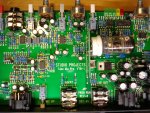Ive read a lot of good things about the VTB1.
I found an old post about this "starved tube" as in VTB1 and other designs, I dont have the authors name but always thought it explained the tube design well. There was a lot of snobbery in the day, probably those who owned $12,000 tube amps not wanting "starved plates" to use the tube-tone description ..

Clip from article>
Often times people associate a "starved plate" tube preamp design as being a negative thing. It really is not, and it may be the answer to your desire for affordable warmth in a cold digital world. Read on:
"Starved plate" is not necessarily as bad a thing as it is made out to be.
Without getting into gory technical details, in order to have the same or similar dynamic performance as a well-designed solid-state preamp, a tube preamp typically needs to have much higher operating voltages because it is much less efficient. This requires big, expensive power supplies so that the anode has a massive charge at all times (usually around 300V to reliably deliver 48V signal or around ~30dBu clean headroom). This is what it takes for a tube preamp to compete with a high-quality solid-state preamp in terms of clean, transparent, high-headroom technical specifications.
HOWEVER, most people who are shopping for a budget tube preamp are not looking for clean, transparent, distortion-free sound-- they are usually looking for the "warm," "fire-y," "fattened and flattened" sound of tubes that are pushed hard.
The fact is that a wide variety of fairly inexpensive solid-state preamps (like the VTB-1 in non-tube mode) (the Rane MS1b) (FMR RNP) (Black Lion Audio and many others) can deliver excellent, high headroom, and fairly uncolored sound in the budget price range. When people who already have such preamps go looking for "tubey warmth," directing them towards a super-clean high-voltage tube preamp is often simply directing them towards a more expensive tube-based version of the sound they already have.
The "problem" with starved-plated designs is that they distort and saturate earlier and at lower signal levels. Technically, of course, this is a bad thing, but the fact is that many people shopping for budget tube preamps are actually looking for that saturated/overloaded tube sound, and not for a super-pristine, super-clean high-headroom sound that compares favorably with high-end solid-state amplifiers or whatever.
As such, delivering lower power to the plate can simply be a way to induce that "tubey" saturation at lower signal levels, something like a guitar distortion pedal that uses an overdriven circuit to achieve a saturated sound that would technically be regarded as "bad," but that is in some cases desirable.
In short, there is nothing wrong with using a "starved plate" tube preamp as a deliberate effect, which is frankly what most home studios would use it for. Dismissing them out of hand is a bit like dismissing a distortion pedal because it distorts the sound-- that's the point, really.
Super-clean, pristine, high-headroom, low-noise preamps typically require big, expensive, high-quality power supplies and components, and tube-based designs even more so. And if clean, transparent, and pristine audio signal is what you're looking for, you're likely going to have to spend some money to get it in a tube design.
But if what you're after is distinctly "tubey" analog saturation, then "starved-plate" design is perfectly capable of delivering it at a much lower price. Whether any particular preamp at any particular price is as good as another is a rather subjective call, but people looking for a "hot" tube flavor should not necessarily dismiss so-called "starved plate" designs out of hand. They are, in effect, a sort of "distortion pedal" whose explicit purpose is to deliver overloaded, distorted signal that approximates the effect of the high-end preamps when driven to capacity.
So, don't go throwing the "Starved Plate" pre's under the bus!


